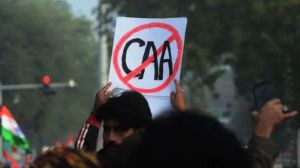To regain lustre, Shimla paints the town red
The deadline had been very clear: the roofs of Shimla’s buildings had to be restored to their earlier glory, by June 30 for government and public institutions, July 3 for others.

Summer vacationers for the past few days have seen herds of painters on the sloped tin roofs of Shimla, with tins of post-office red and olive green. The deadline had been very clear: the roofs of Shimla’s buildings had to be restored to their earlier glory, by June 30 for government and public institutions, July 3 for others. And though paint shops scrambled to meet the demand, the high court’s order put Shimla’s journey into the past well and truly on its way.
At least 70 per cent of the roofs in the main town area, close to the Mall and the Heritage Zone extending up to Chhotta Shimla, have turned strikingly red, making a colourful difference to the hill resort’s skyline. Other structures like those of the Army Training Command have chosen to go green.
The Himachal High Court will review the implementation of its order on July 3. The court had initially fixed March 31 as the deadline for the painting but after requests of citizens and the government, a lease of another three months was granted.
‘‘Isn’t it nice—Shimla has become attractive again,’’ says Rajeev Sharma, an environmentalist-lawyer whose wife Trisha Sharma had filed a public-interest petition in the high court last year. Trisha’s prayer to the court was simple one: ‘‘My lords, kindly direct the Shimla Municipal Corporation to implement MC Building Bylaws 41 (7) of 1998.’’
The bylaws read, ‘‘Every building is required to be painted, distempered, white-washed and roof-painted once in three years by owners/occupants.’’ Since April 2002, under the Town and Country Planning’s interim development plan for Shimla, it is also mandatory for all new buildings to have sloping roofs and painted either maroon or green. The PIL claimed that non-enforcement of the bylaws had robbed Shimla of its unique look.
In its order of September last year, the high court prescribed two colours for the roofs—red or green—and also set the deadline of March 31 for the approximately 30,000 private and public buildings.
What forced the pace was the court’s threat that non-compliance would be construed as contempt of court. Assistant Commissioner Ashwani K Sharma of the Municipal Corporation adds that ‘‘public awareness also played a crucial role and some of the citizens were proactive’’. To educate the citizens,the MC distributed pamphlets, wrote letters to house owners and used the print and electronic media to publicise the court directive.
Some people are grumbling though. Some of the residents living as tenants for two-three generations are unwilling to bear the cost of touching up their roofs. And the harried paintshop owners disclose that a few opted for cheaper, lower quality paints that might not quite withstand the monsoon rain.
As for the official view, Avey Shukla, the state’s principal secretary (Tourism), says, ‘‘There is a need to go beyond painting of roofs to save Shimla from being destroyed by constructions that are not in conformity with hill architecture.’’
Most townspeople would, however, find consonance in the words of S N Joshi, a retired IAS officer and writer. Joshi recalls the late poet Nirmal Verma’s poems on Shimla, compiled into an anthology titled Lal Tin Chhath. He remembers the verses and quietly endorses, ‘‘Yes, the beauty of Shimla lies only in its red roofs.’’



- 01
- 02
- 03
- 04
- 05




























